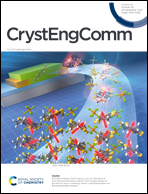Luminescent CdII metal–organic frameworks based on isoniazid using a mixed ligand approach†
Abstract
Herein, we report the syntheses and characterization of two novel CdII-based metal–organic frameworks (MOFs) with the formulae: [{Cd(INH)(hpdia)}·3H2O]α (Cd-MOF-1) and [{Cd(INH)(bdc)}·DMF]α (Cd-MOF-2) (INH = isoniazid, hpdia = 5-(4-hydroxyphenylazo)isophthalic acid, and H2bdc = 1,4-benzenedicarboxylic acid) using the mixed ligand and solvothermal protocol. Single crystal X-ray analysis reveals that Cd-MOF-1 and Cd-MOF-2 display overall 2D porous framework architectures. Cd-MOF-1 and Cd-MOF-2 have a two-dimensional zigzag network composed of a 4-connected uninodal network with sql topology and point symbol {4·4·6·2}. TGA analysis suggests that Cd-MOF-1 and Cd-MOF-2 are thermally stable. These MOFs exhibit fascinating luminescence properties. Cd-MOF-2 shows intense blue emission whereas Cd-MOF-1 shows nearly visibly intense white light emission with a CIE index of (0.34, 0.32) having a color correlated temperature (CCT) of 5121 K. Herein, we show how one can tune their spectral output by varying the emissive and non-emissive organic linkers.



 Please wait while we load your content...
Please wait while we load your content...